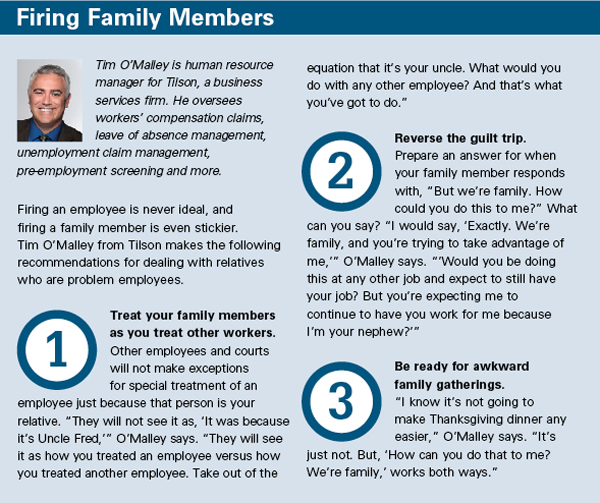To view a PDF of this story, click here.
By Kate Klein, kklein@nrha.org
Employee, We’ve Got a Problem!
Justin looked really good on paper when you hired him three months ago, but he’s been a headache ever since.
You know how critical every sale is to your business, and having an underperformer like Justin on the salesfloor could jeopardize profits. A high-profit hardware store’s gross margin per employee is $88,587, according to NRHA’s 2016 Cost of Doing Business Study. And your store’s gross margin per employee keeps dipping slightly lower than $75,252, beneath what’s typical for the industry.
Yet, you’ve invested time and money into hiring and training Justin, and you still think he shows promise. What should you do?
In this article, Hardware Retailing provides insight on corrective action and termination from two human resource managers who work for thriving independent home improvement operations. Kim Tarrant from Family Farm and Home in Michigan and Lisa Smith from Wilco in Oregon both offer suggestions for helping employees improve their performance or, if necessary, ending their employment quickly. We also share thoughts from Tim O’Malley, who is a human resource manager for Indianapolis-area business services firm Tilson. Their perspectives apply to both large and small operations.
The goal of offering these insights into coaching or firing underperformers like Justin is to help you run a smooth operation that turns payroll dollars into higher profits. The following pages provide employee management strategies, not specific legal advice. Employment laws differ by state, so consult legal counsel or a human resources professional before making decisions.
The article is broken into two sections—first, a look at processes for helping workers succeed and, secondly, a discussion of what to consider when firing problem employees.
Taking Corrective Action
You might notice a worker making mistakes, but more than likely, you’re also getting feedback from other employees and customers about how that worker takes too long to make deliveries and isn’t keeping shelves stocked.
Family Farm and Home, which has 50 locations in Indiana, Michigan and Ohio and about
850 employees, has a goal that is probably the same as yours for every struggling worker,
even if you only operate one store.
“We don’t practice, ‘If A happens, then B happens,’” Tarrant says. “Our goal is always to coach and help team members improve.”

However, Family Farm and Home starts each new employee with a 30-day probationary period, and a manager can use the introductory period as reason for termination, she says.
Thirty days can be enough time to show if a worker’s attitude is affecting the team’s ability to gel and work together or if the employee isn’t going to have reliable attendance. Managers can identify if a person is a bad fit for the business based on whether he or she doesn’t accept coaching, isn’t a team player and has a negative attitude, Tarrant says.
Employee performance problems need to be identified and handled efficiently to avoid interrupted or poor service at the store.
“We want to encourage employees to improve their behavior in order for it not to be obvious to the customer or get in the way of us doing business,” Smith says. She works with nearly 1,000 Wilco staffers, because each store has as many as 50 employees.
Make Expectations Clear
An important step for helping employees succeed is to clearly state your expectations for their performance, O’Malley says. A written policy manual is an important part of that.
Family Farm and Home provides all employees with a handbook that details performance standards and the company’s processes for employee discipline so workers understand up front what the policies are and managers know how to follow the procedures.
“We have in our handbook what we call progressive discipline,” Tarrant says. “There are three steps to our progressive discipline policy, and each case is unique. Depending upon the job each team member is doing and their experience level, they may need different amounts of coaching.”
Those three steps are one verbal reprimand followed by two written warnings, but the process isn’t rigid. Tarrant encourages managers to make sure employees understand their jobs, have the tools they need to succeed and are given opportunities to improve.
She also recommends they talk through employee issues with other managers and consult her office if they have questions. One manager might not realize he isn’t clearly communicating how a job should be done, but another manager’s perspective can help him see the situation differently, she says.
“A lot of issues with our team members arise because our team members either don’t know
what we want them to do or they don’t understand what we want them to do,” Tarrant says.
Starting the Process
The process for corrective action at Family Farm and Home starts with what Tarrant calls verbal counseling. A store manager talks with an employee about a mistake and asks the worker to fix the problem. The initial conversation could be very informal and could happen on the salesfloor.
The manager is expected to keep a written record of any verbal coaching and put the record in the employee’s file.
The next steps in the correction process are written warnings. A manager should have the employee sign those written warnings, or note in writing if the employee refuses to sign them, O’Malley says.
Once a manager has taken corrective action with an employee, O’Malley recommends that the manager have repeated check-in conversations to keep an open dialogue going. Those discussions should affirm that the manager is an ally in the improvement process.
“Have the conversation with the employee that things aren’t going well, but you, the manager, are there to help them correct that,” O’Malley says.
At Family Farm and Home, when conversations aren’t enough to fix the issues, the manager and problem employee meet to develop a written performance improvement plan. They set timelines and goals.
“Continuous follow-up is what we encourage,” Tarrant says. “You start with verbal counseling. Once you’ve exhausted options there, you go to written reprimands.”
The manager must use written reprimands prior to choosing to fire an employee, but doesn’t have to immediately terminate a worker just because he or she has been written up twice, Tarrant says.
“It is our job as managers to help them understand and help them be successful,” she says. “Our managers have to use the progressive discipline. What is not required is a hard-and-fast rule. It’s not two write-ups and then termination. We have to look at each one on a case-by-case basis.”
Wilco managers are also expected to approach individual situations with flexibility and the understanding that each circumstance is unique.
“We take responsibility for the person we hired. We want them to be successful in our environment,” Smith says. “When they don’t do well, we have to backtrack and say, ‘Where did we go wrong? Was this a bad hiring decision? Or a difficult time in their lives?’”
The Path to Termination
Some infractions—such as sexual harassment or repeatedly failing to show up for work—can make firing an employee pretty straightforward, if not legally necessary.
A company’s discipline policy should allow employees to have opportunities to correct their mistakes, as well as the option to immediately terminate employment due to egregious behavior, such as violent acts, O’Malley says.
Other reasons for instant termination would include stealing, sexual harassment, racial discrimination, selling or abusing illegal drugs on business property, creating safety risks for employees or customers, insubordination and falsifying legal documents.
Regardless of whether immediate firing is necessary, the path to firing an employee should be well documented in writing to protect the company.
Making the Decision
If employees’ actions don’t necessitate immediate termination, then ask them questions and pay attention to how willing they are to accept correction and training.
“Go into a conversation not assuming that the employee knew that what they were doing was wrong,” O’Malley says. “It’s coaching, as opposed to having to discipline someone. Stay calm. Do it one-on-one. Allow the employee to save some face.”
Before you decide to fire an employee, have private meetings and listen to the worker’s side of the story.
“Have a process by which an employee can raise concerns and report any issues they say that could violate a policy,” O’Malley says.
“What you want is the employee to clearly understand what it is that they’re doing incorrectly and what it is that they need to be doing differently in comparison to what they’re doing now.”
Tarrant encourages store managers to consider carefully whether to fire, and then make termination decisions based on how many performance problems they have documented about the employee, how much time has passed between written warnings and whether they have given the worker adequate time to improve.

Firing is also a decision the company needs to make with the business’ return on investment in mind, Smith says. A manager has the responsibility of deciding if an employee is progressing toward becoming a better team member, needs more time to improve or should be terminated.
Wilco won’t fire a worker because of a minor infraction, but the company does have to decide how long it is going to invest in trying to train a person who is a bad fit, Smith says. Managers also have to think through whether discipline, such as a demotion, is worthwhile. Choosing to continue training or moving an employee to a new position needs to be a smart business decision, she says.
How managers approach the conversations about employee performance and termination is significant, Smith says.
“Doing it empathetically is really important,” she says. “I’d like to think, when an employee has an issue, that they can speak about it without feeling disrespected. It doesn’t mean they’re bad people.”
The Legal Side
Managers should carefully and consistently follow store policies when reprimanding and then firing employees in order to protect the business legally, O’Malley says.
If the company handbook is clear about expectations and correction is needed, then don’t wait until an employee is hurting staff morale and business operations before you confront problems.
“Whatever the issue is, make sure you are addressing it with the individual early and often,” O’Malley says.
Companies operating in right-to-work states can fire employees at will, but best practices for termination would include well-documented reprimands and written descriptions of complaints from other employees, he says.
Termination should be a last resort, but when you have to do it, your careful documentation can help protect your company from employee lawsuits.
You cannot prevent employment-related lawsuits because workers can file charges with the Equal Employment Opportunity Commission without help from an attorney. However, you can keep careful written records of employee conduct and give your company a strong defense in court, O’Malley says.
Firing people during probationary periods at the start of their careers with your business won’t protect your operation legally in the way that disciplinary actions over time will.
“That is why the progressive discipline process is critical,” Smith says. “You need information to prove that the termination was warranted.”
Another way for a business to protect itself from employment-related lawsuits is to be very consistent in how it treats every employee’s benefits so workers don’t have grounds for making discrimination allegations.
For example, if your business offers paid or unpaid absences for workers when a crime or accident is under investigation at the store, then don’t opt to give paid leave on a case-by-case basis, O’Malley says.
“That’s where you’re going to get yourself in hot water,” he says.
A paper trail and consistency can protect you, your managers and the company from legal risks, such as false accusations of discrimination based on age, gender, health, race, religion or sexual orientation.

Ending Well
If you follow employment best practices, then your staffers should not be surprised if they are fired.
Workers should expect termination after months of progressive discipline because a manager has repeatedly addressed their poor performance verbally and in writing, talking about how to improve, as well as what the consequences will be if the problems aren’t fixed, Tarrant says. Regular communication makes the final meeting part of a logical, well-understood progression.
“No team member is to be fired without proper documentation,” Tarrant says. “Managers should be able to show the team member the verbal counseling record and performance improvement plan and be able to say, ‘You were coached multiple times. We’re still not seeing change.’ That makes those conversations easier because they have documentation to back up their decision for termination.”
Prompt firing after an egregious act shouldn’t be surprising, either, because properly trained employees should know company policies.
If employees are unable to perform their jobs or do not follow their performance improvement plans, then they will know what’s coming and why when they get fired, Tarrant says.
At Wilco, a worker who is on a performance improvement plan gets regular coaching and meets with his or her supervisor every other week or more often to discuss how the process is going. The intention is not to get rid of an employee in a way that will hold up in court, but to help that person succeed, Smith says.
“A lot of employees don’t know how to improve. If you hire an 18-year-old kid, it might be their first real job,” she says. “I think goals are imperative. People learn at different rates, absorb at different rates.”
Wilco staff members who don’t make progress on their performance improvement plans typically end up leaving instead of getting fired.
“Because we take so much interest in their development, a lot of employees realize they can’t do it and leave on their own,” Smith says.
When employees don’t leave on their own and need to be let go, then the managers will ask them to find employment elsewhere. But that doesn’t mean the manager should send the workers away feeling disrespected, Smith says.
“Empathy is about connecting physically. Making eye contact with the individual. It’s the handshake at the end of the meeting,” she says. “It’s about being positive, and it’s about explaining the infraction in detail and why the infraction is leading to progressive discipline
or termination.”
Tools for Your Operation
Hardware Retailing has compiled the following tools for you to consult or use in operating your business:
 Hardware Retailing The Industry's Source for Insights and Information
Hardware Retailing The Industry's Source for Insights and Information








